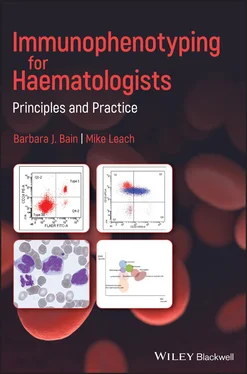An immunophenotyping result will often also be subsequently incorporated into an integrated report that includes the results of other types of investigation, for example, morphological assessment and cell counts, and cytogenetic or molecular genetic analysis.
Immunohistochemistry predominantly employs a primary monoclonal antibody directed at the target antigen, followed by a secondary anti‐immunoglobulin antibody that is coupled to an enzyme; the enzyme can subsequently participate in an enzymatic reaction, producing a coloured product that can be visualised. The most frequently used technique is an immunoperoxidase reaction. For some purposes, for example, the detection of immunoglobulin components, polyclonal antisera may be preferred. Immunohistochemistry has an advantage over flow cytometry in that antigen expression can be related to cytological and histological features. Co‐expression of antigens can be studied by using two different enzymatic reactions (such as peroxidase and alkaline phosphatase) or by identifying the same cell population in serial sections of the tissue.
Interpretation and Limitations of Flow Cytometric Immunophenotyping
Flow cytometry must not be interpreted in isolation but in the light of the clinical history, findings on physical examination and the results of other investigations. In particular, the blood or bone marrow film should be carefully examined in the light of the clinical and laboratory findings. Specimens are frequently sent for flow studies where the referring clinician does not have a working diagnosis. For example, a patient presenting with pancytopenia could have a number of potential diagnoses including acute leukaemia, myelodysplastic syndrome, a lymphoproliferative disorder or aplastic anaemia. A morphological review is essential in order that an appropriate panel of antibodies is utilised. Not uncommonly an abnormal cell population in the blood is present at low levels, examples being acute leukaemia, high grade lymphoma and hairy cell leukaemia. The cells identified as being of potential interest morphologically must be correlated with abnormal populations seen in scatter plots so that an appropriate gating strategy is utilised.
Clearly technical errors can lead to erroneous results of immunophenotyping. Rigorous quality control is required. Inappropriate selection of antibodies and erroneous interpretation can result from inadequate clinical information being provided or from failure to examine a film of the peripheral blood or bone marrow aspirate that is to be tested. Delays in transportation of a sample to the laboratory can lead to cell death and make testing of the sample unwise since results are likely to be misleading.
Errors in interpretation can occur if the results of immunophenotyping are not integrated with clinical, haematological, cytogenetic and genetic information. Not all cases of a specific condition will have a typical immunophenotype and, in some entities, the immunophenotype is not distinctive.
In certain circumstances flow cytometry of a bone marrow aspirate will show no abnormality despite a neoplastic infiltrate being present. This is likely to occur when there is diffuse or focal bone marrow fibrosis, when the aspirate is of low cellularity and when neoplastic cells are infrequent, fragile or dead. Findings are typically negative in Hodgkin lymphoma where the disease cells, Hodgkin and Reed–Sternberg cells, are present at a low frequency amongst a reactive environment of lymphocytes, plasma cells and eosinophils with associated reticulin fibrosis. In these circumstances it is trephine biopsy histology and immunohistochemistry that yield the diagnosis. It is therefore important not to exclude a diagnosis completely based solely on the results from one approach, particularly where the specimen quality is poor. No single investigation in isolation is infallible – by correlating the results of several investigations using different modalities, a unifying diagnosis can be achieved.
1 1 Illingworth AJ, Marinov I and Sutherland DR (2019) Sensitive and accurate identification of PNH clones based on ICSS/ESCCA PNH Consensus Guidelines. Int J Lab Haematol, 41, Suppl. S1, 73–81.
2 2 Knight V (2019) The utility of flow cytometry for the diagnosis of primary immunodeficiencies. Int J Lab Haematol, 41, Suppl. S1, 63–72.
3 3 Ammann S, Lehmberg K, Zur Stadt U, Janka G, Rensing‐Ehl A, Klemann C et al. for HLH study of the GPOH (2017) Primary and secondary hemophagocytic lymphohistiocytosis have different patterns of T‐cell activation, differentiation and repertoire. Eur J Immunol, 47, 364–373.
4 4 Marsh RA and Haddad E (2018) How I treat primary haemophagocytic lymphohistiocytosis. Brit J Haematol, 182, 185–199.
5 5 Sabato V, Verweij MM, Bridts CH, Levi‐Schaffer F, Gibbs BF, De Clerck LS et al. (2012) CD300a is expressed on human basophils and seems to inhibit IgE/FcεRI‐dependent anaphylactic degranulation. Cytometry B Clin Cytom, 82, 132–138.
1 Béné MC (2019) The wonderful story of monoclonal antibodies. Int J Lab Hematol, 41, Suppl. S1, 8–14.
2 Gorczyca W (2017). Flow Cytometry in Neoplastic Hematology: Morphologic‐Immunophenotypic Correlation, 3rd edn. CRC Press, Boca Raton.
3 Leach M, Drummond M and Doig A (2013) Practical Flow Cytometry in Haematology Diagnosis. Wiley‐Blackwell, Oxford.
4 Ortolani C (2011) Flow Cytometry in Haematological Malignancies. Wiley‐Blackwell, Oxford.
5 Porwit A and Béné MC (2018) Multiparameter Flow Cytometry in the Diagnosis of Hematologic Malignancies. Cambridge University Press, Cambridge.
6 Swerdlow SH, Campo E, Harris NL, Jaffe ES, Pileri S, Stein H and Thiele J (eds) (2017) WHO Classification of Tumours of Haematopoietic and Lymphoid Tissues, revised 4th edn. IARC Press, Lyon, pp. 37–38.
Конец ознакомительного фрагмента.
Текст предоставлен ООО «ЛитРес».
Прочитайте эту книгу целиком, на ЛитРес.
Безопасно оплатить книгу можно банковской картой Visa, MasterCard, Maestro, со счета мобильного телефона, с платежного терминала, в салоне МТС или Связной, через PayPal, WebMoney, Яндекс.Деньги, QIWI Кошелек, бонусными картами или другим удобным Вам способом.












